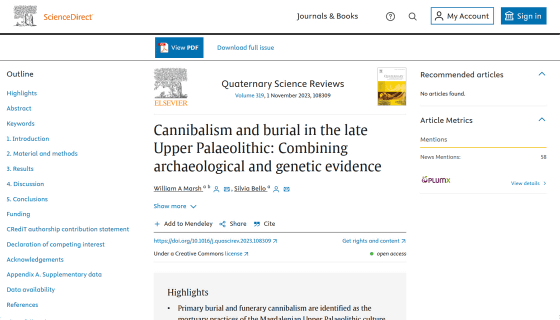Research results show that Europe once had a culture of ``cannibalizing'' corpses as funerals

Today, most cultures around the world use burial or cremation for funerals. However, in
Cannibalism and burial in the late Upper Palaeolithic: Combining archaeological and genetic evidence - ScienceDirect
https://www.sciencedirect.com/science/article/pii/S0277379123003578

Oldest evidence of human cannibalism as a funerary practice | Natural History Museum
https://www.nhm.ac.uk/discover/news/2023/october/oldest-evidence-of-human-cannibalism-as-a-funerary-practice.html
'People Were Eating Them': Long Ago Cannibalism Was Normal, Study Says : ScienceAlert
https://www.sciencealert.com/people-were-eating-them-long-ago-cannibalism-was-normal-study-says
The Madeleine culture was a culture that existed in northwestern Europe during the Upper Paleolithic period, and its main ruins are distributed in France, Spain, and England. The Madeleine culture site at Gough Cave in Cheddar , Somerset , England, has found evidence of skulls being made into cups or bowls, and evidence suggesting cannibalism of the remains.
The photo below is of the actual skull cup discovered at Gough Cave.

by Wikimedia Commons
However, it was unclear whether cannibalism was a common cultural practice in the Madeleine culture, or whether the group living in Gough's Cave was unique. A research team led by paleoanthropologists Sylvia Bello and William Marsh from the Natural History Museum in London analyzed 59 sites thought to be related to the Madeleine culture.
As a result, human funeral behavior was confirmed at 25 of the 59 sites, with 10 sites where bodies were buried or kept, and 13 sites where cannibalism was practiced for funerals. Evidence found. The two remaining sites showed evidence of both burial and cannibalism. Evidence of cannibalism has been found, including scars and tooth marks associated with the reuse of corpses as utensils such as tableware, and eating bone marrow, as well as carvings that appear to have been used for decorative purposes.
The figure below shows the distribution of the 59 ruins analyzed this time and the confirmed funeral rituals. Blue triangles are ruins where rudimentary burials have been confirmed, red squares are ruins where cannibalism has been confirmed, and black dots are ruins where funerary rituals have not been confirmed.

The results of this analysis indicate that cannibalism for funerary purposes was widespread in the Madeleine culture. 'They ate their dead instead of burying them,' Bello said. 'We have evidence that cannibalism occurred multiple times across northwestern Europe within a short period of time, and we have evidence that this practice was practiced in Madeleine populations. 'This is the earliest evidence of cannibalism as a funerary custom, which is interesting in itself.'
Furthermore, the research team analyzed eight sites for which detailed genetic information on human bones was available. All of these ruins were thought to be related to the Madeleine culture, but analysis of their genetic information revealed that they belonged to a group whose ancestors inherited the gene GoyetQ2, which is related to the Madeleine culture, and other ruins mainly located in southeastern Europe. It turns out that there is a mixture of groups that inherited from their ancestors a gene called ``Villabruna'' related to the flourishing Epigravet culture . Furthermore, it was found that all of the ruins with a culture of cannibalizing the dead belong to the 'GoyetQ2' gene group.
The fact that funeral customs differ between genetic groups suggests that the shift in funerary rites in northwestern Europe from cannibalism to burial was not due to the Madeleine culture adopting new customs, but rather because the Epigravets were taking over the Madeleine culture. It suggests that it has changed.
William said: 'The late Paleolithic period shows a reversal in both genetic ancestry and funerary rites, meaning that the ancestry and funerary rites associated with the Madeleine culture were replaced by those associated with the Epigravet culture. This indicates that the Epigravet culture group moved to northwestern Europe and replaced the population.We believe that this change in funerary rites 'Rather than being an example of cross-cultural spread, we believe this is an example of demic spread (population spread), where one group moves to replace another.'
Related Posts:
in Science, Posted by log1h_ik







